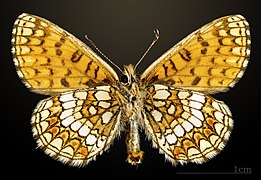Species of butterfly
.mw-parser-output .hidden-begin{box-sizing:border-box;width:100%;padding:5px;border:none;font-size:95%}.mw-parser-output .hidden-title{font-weight:bold;line-height:1.6;text-align:left}.mw-parser-output .hidden-content{text-align:left}@media all and (max-width:500px){.mw-parser-output .hidden-begin{width:auto!important;clear:none!important;float:none!important))You can help expand this article with text translated from
the corresponding article in French. (August 2018) Click [show] for important translation instructions.
View a machine-translated version of the French article.
Machine translation, like
DeepL or
Google Translate, is a useful starting point for translations, but translators must revise errors as necessary and confirm that the translation is accurate, rather than simply copy-pasting machine-translated text into the English Wikipedia.
Consider
adding a topic to this template: there are already 6,211 articles in the
main category, and specifying|topic= will aid in categorization.
Do not translate text that appears unreliable or low-quality. If possible, verify the text with references provided in the foreign-language article.
You must provide
copyright attribution in the
edit summary accompanying your translation by providing an
interlanguage link to the source of your translation. A model attribution edit summary is Content in this edit is translated from the existing French Wikipedia article at [[:fr:Melitaea aurelia]]; see its history for attribution.
You may also add the template ((Translated|fr|Melitaea aurelia)) to the
talk page.
For more guidance, see
Wikipedia:Translation.
Melitaea aurelia, or Nickerl's fritillary, is a butterfly of the family Nymphalidae. It is found in central Europe.
Description
The wingspan is 28–32 mm. Dark russet-brown, so strongly marked with black that the ground-colour is reduced in the female to very small spots. On the whole similar to Melitaea athalia, but smaller, with the black markings deeper in tint and heavier, the ground-colour darker, more brownish; beneath the marginal line before the fringes is absent or but very indistinct. The species is recognizable by the palpi bearing foxy red hairs, while the palpi of athalia are whitish, being occasionally somewhat reddish yellow and then only at the base.[1]
Biology
The butterfly flies from June to August depending on the location.
The larvae feed on Plantago lanceolata, Melampyrum pratense and yellow rattle.


